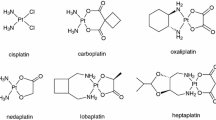Abstract
A series of novel indole derivatives were designed, synthesized and evaluated for the binding affinity of Bcl-2 family proteins and antiproliferative activity against three selected cancer cell lines (PC-3, Jurkat, and MDA-MB-231). The preliminary structure-activity relationship (SAR) for this indole scaffold was summarized. Among all the compounds, compound 9k showed the best inhibitory activity against Bcl-2 and Mcl-1 proteins with IC50 values of 7.63 µM and 1.53 µM, respectively, which is comparable to the positive control AT-101. The docking study of it with Bcl-2 and Mcl-1 proteins indicated that it could bind to the active pocket of them through Van der Waals forces, hydrogen bond, etc. However, the three compounds with good binding affinity of Bcl-2 protein exhibited weaker antitumor activity compared to AT-101, which need further modification.





Similar content being viewed by others
References
Zhang S, Chen Y, Tian C, He Y, Tian Z, Wan Y, et al. Dual-target inhibitors based on BRD4: Novel therapeutic approaches for cancer. Curr Med Chem. 2021;28:1775–95.
Dadashpour S, Emami S. Indole in the target-based design of anticancer agents: A versatile scaffold with diverse mechanisms. Eur J Med Chem. 2018;150:9–29.
Zhang Z, Xing X, Guan P, Song S, You G, Xia C, et al. Recent progress in agents targeting polo-like kinases: Promising therapeutic strategies. Eur J Med Chem. 2021;217:113314.
Kaushik NK, Kaushik N, Attri P, Kumar N, Kim CH, Verma AK, et al. Biomedical importance of indoles. Molecules. 2013;18:6620–62.
Wan Y, Fang G, Chen H, Deng X, Tang Z. Sulfonamide derivatives as potential anti-cancer agents and their SARs elucidation. Eur J Med Chem. 2021;226:113837.
Taber DF, Tirunahari PK. Indole synthesis: a review and proposed classification. Tetrahedron. 2011;67:7195–210.
Liu T, Song S, Wang X, Hao J. Small-molecule inhibitors of breast cancer-related targets: Potential therapeutic agents for breast cancer. Eur J Med Chem. 2021;210:112954.
Liu T, Wu Z, He Y, Xiao Y, Xia C. Single and dual target inhibitors based on Bcl-2: Promising anti-tumor agents for cancer therapy. Eur J Med Chem. 2020;201:112446.
Wan Y, Li Y, Yan C, Yan M, Tang Z. Indole: A privileged scaffold for the design of anti-cancer agents. Eur J Med Chem. 2019;183:111691.
Kumari A, Singh RK. Medicinal chemistry of indole derivatives: Current to future therapeutic prospectives. Bioorg Chem. 2019;89:103021.
Tantawy MA, Nafie MS, Elmegeed GA, Ali IAI. Auspicious role of the steroidal heterocyclic derivatives as a platform for anti-cancer drugs. Bioorg Chem. 2017;73:128–46.
de Sá Alves FR, Barreiro EJ, Fraga CA. From nature to drug discovery: the indole scaffold as a ‘privileged structure’. Mini Rev Med Chem. 2009;9:782–93.
Liu T, Wan Y, Liu R, Ma L, Li M, Fang H. Design, synthesis and preliminary biological evaluation of indole-3-carboxylic acid-based skeleton of Bcl-2/Mcl-1 dual inhibitors. Bioorg Med Chem. 2017;25:1939–48.
Kim SH, Sperry J. Synthesis of Alocasin A. J Nat Prod. 2015;78:3080–2.
Atadja P. Development of the pan-DAC inhibitor panobinostat (LBH589): successes and challenges. Cancer Lett. 2009;280:233–41.
Liu T, Wan Y, Xiao Y, Xia C, Duan G. Dual-target inhibitorsbBased on HDACs: Novel antitumor agents for cancer therapy. J Med Chem. 2020;63:8977–9002.
Xu G, Liu T, Zhou Y, Yang X, Fang H. 1-Phenyl-1H-indole derivatives as a new class of Bcl-2/Mcl-1 dual inhibitors: Design, synthesis, and preliminary biological evaluation. Bioorg Med Chem. 2017;25:5548–56.
Acknowledgements
This work was supported by grants from National Natural Science Foundation of China (No. 82104123), Natural Science Foundation of Shandong Province (No. ZR2020QH344), and the Project of Shandong Medical and Health Science and Technology (No. 2019WS393).
Author information
Authors and Affiliations
Corresponding authors
Ethics declarations
Conflict of interest
The authors declare no competing interests.
Additional information
Publisher’s note Springer Nature remains neutral with regard to jurisdictional claims in published maps and institutional affiliations.
Supplementary Information
Rights and permissions
Springer Nature or its licensor (e.g. a society or other partner) holds exclusive rights to this article under a publishing agreement with the author(s) or other rightsholder(s); author self-archiving of the accepted manuscript version of this article is solely governed by the terms of such publishing agreement and applicable law.
About this article
Cite this article
Liu, Y., Li, J., Zhou, G. et al. Design, synthesis and anticancer activity studies of novel indole derivatives as Bcl-2/Mcl-1 dual inhibitors. Med Chem Res 32, 99–108 (2023). https://doi.org/10.1007/s00044-022-02991-y
Received:
Accepted:
Published:
Issue Date:
DOI: https://doi.org/10.1007/s00044-022-02991-y




